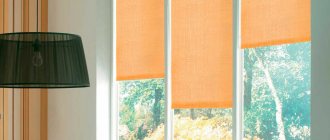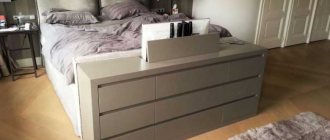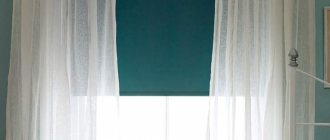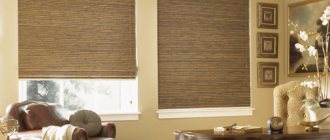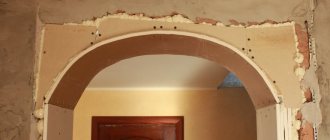Roman blinds are a modern and practical solution for any interior.
Interior elements such as curtains, curtains and drapes have become an integral part of the style and modern transformation of the window and the entire room. Particularly popular are Roman and roller variations, which in the process of operation use lifting mechanisms for curtains.
It is comfortable to use such designs, they look beautiful and can complement any room design. We will talk about the features of their operation and the operation of structural components below.
Roller blinds are a very convenient and compact design, which, first of all, reliably protects the room from sunlight and prying eyes.
Introduction to curtains
In order not to get into trouble during manufacturing, and not to regret the decision for a moment, it is better to get acquainted in detail with the new design, operating principle, and varieties of these curtains.
How does the roll mechanism work?
The main element of roller devices is a rod with a circular cross-section, its task is to raise or lower curtains: partial or complete. This is achieved using a cord that drives the shaft. To fix the straightened fabric, a weighting agent is provided in the design. Cords, ribbons or other similar elements act as garters. The location of the bar may vary. In some models it is located at the bottom, simultaneously serving as a load; in other designs, the shaft is attached to the frame or cornice.
Despite the same principle of operation, roller blinds are somewhat different in design. Some models are equipped with additional elements that are designed to improve the appearance and make operation more comfortable. To protect the fabric from dust, some models are equipped with closed boxes for the roller. No less popular are practical roller shutters, which contain magnetic tapes or guides that prevent distortions of fabric rolls.
What will outweigh: pros or cons
Before planning to construct a mechanism for roller blinds with your own hands, you need to comprehensively evaluate the feasibility of such a solution. Therefore, it would be useful to show the advantages of roller blinds, but at the same time point a finger at their disadvantages. Advantages that many will agree with:
- reliable protection from prying eyes due to the tight fit to the opening;
- ease of installation on the cornice or frame of any window: both plastic and wooden;
- maximum free space, which traditional curtains cannot boast of;
- roller blinds play two roles at once, because in addition to curtains they are used as fabric blinds;
- the possibility of combination with other similar products - lambrequins, curtains, tulle.
This also includes savings if you plan to make roller blinds yourself, since very little materials, including textiles, are required.
Disadvantages, alas, are present in everyone and everything, roller shutters are no exception. Among the “flies in the ointment”:
- insufficient variability in light intensity adjustment, which distinguishes roller blinds from blinds;
- potential malfunctions if a simple model without guides is selected.
These disadvantages are unlikely to outweigh the mass of advantages; this difference is the secret to the success of these designs. Roller shutters can be found at every step: in apartments, private houses, shopping centers, enterprises and offices.
Types of structures
When planning to build a mechanism for roller blinds with your own hands, you need to become familiar with the design features of roller blinds in advance. There are several types of lifting devices, each of them has both advantages and disadvantages. Their types:
- Spring. These mechanisms can be installed from the bottom or top of the curtains. The advantage is that there is no need to manipulate the holders, since all the work is done automatically - using a spring. However, the downside lies precisely in these parts; they wear out quickly, so they will require frequent replacement.
- Chain ones are the simplest, practically fail-safe designs. The curtains in them are adjusted manually - using a rope, a plastic chain or a cord. These elements, thrown over the bar, are fixed in the lower part of the structure. When the rope is pulled, the roller begins to rotate, lowering or raising the fabric. In this case, holders (garters, clips) are needed to fix the canvas in a certain position. Here it is the simplicity of the design that guarantees its durability. Another plus is the low cost.
- Electric drive systems. It is quite difficult to make such a mechanism for roller blinds with your own hands, since the design is equipped with an electric motor that opens and closes the curtains. Manipulations require a remote control or switch. The advantage is ease of operation, the disadvantage (besides labor intensity) is the high cost. Such lifting mechanisms are the only option for large openings - on panoramic or roof windows.
This roller category mistakenly includes another type of curtains - Roman curtains. However, despite all the external similarity, the difference is still great: roller shutters have a shaft onto which the fabric is wound, while the “Romans” are simply assembled in folds.
Spring
This mechanism allows you to fix the fabric in a constant tension state, eliminating sagging of individual sections of the fabric. It completely lacks a chain system; the structure is controlled using the regulator handle. The shaft rotates using a spring and is fixed thanks to a locking element.
Roller blinds with a spring mechanism are free-hanging systems that are controlled by a spring.
Spring structures are popular not only on vertical surfaces, but also for closing window niches that are located on a slope (for example, an attic). Very often it is used as a basis for fabric with photo printing.
Roller blinds with a spring mechanism are also worth buying because their design does not have small parts that, if broken, can get into the body of small children.
The spring type of mechanism is considered an unreliable design, since the spring stretches and wears out over time. But with proper care and careful use, the product can last quite a long time.
The spring mechanism allows you to attach the curtain both at the top and bottom of the frame.
Sewing roller blinds yourself
Before you start sewing such products, you should measure the window opening and take into account the method of fastening: on the cornice, in the window opening, on the frame.
We offer several simple options for making roller blinds yourself, which differ in the method of fastening and the mechanism for raising the canvas.
Cutting and sewing fabric
- When cutting, the dimensions obtained when measuring the window should be added in width - 2.5 cm for allowances, in length - up to 15 cm for “pockets” and allowances.
- Cut out two fabrics (for the front and back of the curtain). They can be from the same fabric or from different ones.
Fold the fabric face to face and stitch on three sides (from the wrong side!)
Important!. If the window is large and it is necessary to sew two strips in the center, then you need to make sure that the seam falls on the frame binding
This way it will be less noticeable
If the window is large and it is necessary to sew two strips in the center, then you need to make sure that the seam falls on the frame binding. This way it will be less noticeable.
- Turn the fabric inside out, carefully sew up the remaining side and press the seams.
Further actions depend on the method and mechanism of fastening.
Mounting on a cornice
In this case, you need to do the following:
- sew two “pockets” on the curtain: on the top - for the curtain rod, on the bottom - for the weighting (wooden or metal) strip. Next, sew plastic rings on top on both sides;
- Screw in hooks on the sides of the window opening from above. After this, you can hang and arrange a mechanism for raising the curtains;
- take two cords (one for three lengths of the finished model, the second for three lengths of the curtain and its width);
- tie the end of the first cord to the hook, pass through the bottom of the product and thread it through the ring;
- fasten the second cord in the same way, but pass it through both rings in sequence;
- gather the cords together and fasten them.
Lifting mechanism: when the cords are pulled, the curtain will be wound up due to the counterweight.
Making a roller curtain with your own hands
Beam mount
In this option, it is necessary to prepare a wooden beam, which will be attached from above into the window opening or to the frame. For greater aesthetics, you can wrap it in fabric, and then attach one piece of Velcro tape to the bottom.
As in the previous case, a “pocket” should be made at the bottom of the curtain for the weighting material. Carefully sew the second part of the Velcro tape on top.
The fastening tapes are cut out and sewn separately. You can use ready-made decorative cords or ribbons; their length should be equal to two curtain lengths plus 15-20 cm.
Fasten this beam to the window, first passing the fastening tapes on both sides.
What curtains is it suitable for?
The above designs are used for various types of curtains that open upward. They have fixed parameters and are not adjustable in width. As a rule, the area of the canvas coincides with the size of the window opening. Often such products are called flat curtains, since when open they present a flat surface without folds or sagging.
It is comfortable to use such designs, they look beautiful and can complement any room design.
All lifting curtains can be divided into several large groups:
- Roller blinds. This is essentially a wide strip of fabric that is wound around a shaft, freeing up space. It is easy to move up and down and leave in the desired position.
Note! Sometimes consumers confuse thin strip blinds with roller blinds. But these are completely different products. The latter are more practical and effective. They do not require washing, do not attract large quantities of dust, and can provide denser and better-quality darkness on sunny days.
- Roman. Curtains consist of separate horizontal sections, between which thin slats are inserted. As the canvas rises, it falls in uniform folds across its entire width.
- English. These models are similar to previous products, but are distinguished by greater fluffiness of the folds due to additional volumes of fabric.
- Austrian. They are divided into vertical sections, between which, when lifted, wavy folds are formed. Even when deflated, the canvas is slightly gathered at the bottom.
- French. They are similar to the Austrian models, with one difference: they have more small folds.
All these curtains can provide reliable protection of the room from direct sunlight, save space and complement the interior design of the interior. Their movement is carried out using different structures, most of which can be installed independently.
When decorating a window, they look very elegant, create an original and unique design and bring a special charm to the room.
Sewing a bottom-rolling curtain
You can make a roller blind of a different design with your own hands, with a simpler mechanism of action. In this case, the roll bar is located at the bottom, serving as a weighting agent. The curtain fabric is cut and sewn in exactly the same way as in the first case.
At the top, the curtain is fixed to a wooden strip (a). The drawstring for the bar is made from below (b). The wooden plank is attached with self-tapping screws to the wall or window (c). The curtain is fixed with tapes (d)
You can also secure the curtain with a stapler, furniture nails, or, as an option, with adhesive tape and Velcro, which makes it easy to remove the curtain for washing.
The curtain is wound onto the roller by hand and secured with braid or tape. You will need two ribbons equal to two and a half curtain sizes. Each tape should be located at a certain distance from the edge of the canvas. It needs to be thrown over the curtain and secured at the top.
You can also use decorative cord instead of ribbons by passing it through the eyelets made at the top
There is also the option of securing the cord through loops. The curtain will be in a curled state with its help, but you will need to secure it to the wall or frame
If necessary, the curtain is rolled onto a roller and secured with tapes.
In addition to attaching the roller blinds to the rail, in the case where the roller is made at the bottom, they can be hung on a cornice with a round cross-section using sewn loops, or another drawstring can be made at the top to fit the size of the cornice.
Automatic control
Relatively new products are mechanisms equipped with an electric drive. This is a modern device that can work automatically, without physical effort on the part of a person. The design is equipped with a small motor, which is located in the shaft and ensures the raising and lowering of the curtains.
Automatic electric curtain rods with electric drive come in several types and have different purposes.
In this case, control occurs using a remote control. By pressing the appropriate buttons, you can move and stop the curtain at the desired level. Electrical structures are a modern component of a smart home; they can be controlled individually for each set, or comprehensively for a room.
Automatic curtains are really very convenient.
This product costs an order of magnitude more than previous options, but it is more functional and practical in everyday life. The mechanism can be equipped with curtains of various weights, shapes and volumes. This is especially convenient when they are too high.
It is important to choose the right profile cornice for the type of curtains you are going to use.
Advantages of roller blinds
The popularity of roller blinds is due to their many advantages. The following can be distinguished from them:
- It is possible to use such roller blinds as an independent element of window design or as an addition to existing curtains. This significantly expands the scope for creativity, which allows you to realize your wildest design ideas by decorating the room to your liking.
- Roller blinds, due to their functionality, simplicity of design and attractive appearance, have today almost completely replaced the blinds that were popular in the past. This design option is ideal for plastic windows, and due to its versatility it can be used in classic and modern interior design styles.
- It is possible to use roller blinds with plastic double-glazed windows and wooden windows. It is possible to design windows with high quality, regardless of their material, shape and design.
- Roller blinds that are correctly sized and installed with high quality will fit tightly to the windows, which solves the problem of curious glances from passers-by. In particular, such roller blinds will be relevant for owners of private cottages and residents of the first floors of high-rise buildings.
- The design of the curtains allows you to completely darken the room or reduce the intensity of the bright sun. It is possible to choose a canvas with different light transmittance characteristics, which will solve the problem of room lighting during daylight hours.
- Such designs are distinguished by durability, quality and wear resistance.
- Throughout their entire service life, such roller blinds retain all their functionality.
- The variety of options available allows you to choose them both to match the characteristics of specific windows and the style of room design.
- It is possible to independently produce such roller blinds, which allows you to save on window decoration.
Rope
This is the simplest type of design and is often used as a mechanism for Roman blinds. It includes the following elements:
- The main cord that connects to the ropes that hold the horizontal slats.
- A roller that directs the force from the main cord to the frame.
The rope system works simply - you pull the rope and the curtain rises.
Adjustment of the degree of opening of the curtain occurs as a result of changing the length of the threads (cables), which pull the curtain to any position, folding it into an “accordion” or gathering it into folds.
This simple operating mechanism provides the advantage that such curtains can be hung even on a curved surface.
How to sew curtains yourself (equipment and tools)
To sew simple curtains yourself, you should prepare the equipment.
Prepare all the necessary materials for sewing curtains.
Sewing machine. It will help you sew curtains correctly. When purchasing, you should pay attention to the fact that there is a zigzag function and a buttonhole foot. Ruler. It’s better to have several: a small school one, one and a half meters and a square. The main thing is that the divisions are visible, in which case the cut will be correct. Pattern. A special tool that will allow you to make beautiful curved lines. Chalk. But not ordinary, but tailor-made. It can be replaced with a soap with a sharp edge. Tape measure. On it, as on the ruler, the divisions should be clearly visible. Scissors
It is important that they are well sharpened. It's better to have several pairs in stock
Tailors are needed for fabric, and regular ones are needed for paper patterns. Pins. For fastening parts.
Advice! Choose brightly colored pins so that they are easy to spot on the floor.
Once you are sure that everything is ready, you can start creating.
- Needles. They should be different so that, if necessary, they are suitable for both thick and thin fabrics.
- Needles for the machine. The thickness depends on the density of the fabric. When purchasing a machine, you should also buy a set of needles.
- Threads. The thickness of the threads will depend on the material.
- Thimble and steam ripper. A thimble will protect your middle finger, and a seam ripper will help you quickly unravel the seam.
- Iron. Will be needed when ironing the finished product.
Transparent and translucent
The first properties are similar to the usual tulle. They allow a lot of natural light into the room. Most often used in combination with classic curtains. The latter block access to direct rays of the sun, providing soft, diffused light.
Hide from the sun
Most often, during the day, the curtains are opened in order to protect the room from the sun's rays, which provide light and warmth. But when the sun is bright, curtains will help hide from it. You can make unusual curtains for the balcony from the sun with your own hands from the most ordinary paper wallpaper. However, it is best to choose a more durable wallpaper - vinyl, for example, or fiseline. You will also need:
- stapler;
- single-sided tape;
- double sided tape;
- wooden slats to the size of the sash;
- metal ruler;
- pencil;
- non-writing pen or knitting needle;
- scissors;
- beautiful decorative cord to match the wallpaper.
Measure the wallpaper according to the size of the window sash, since these curtains are attached individually. From below, parallel to each other, mark the folds at a distance of 4-5 centimeters from one another. Using a non-writing pen or knitting needle, press the drawn lines through one, first from the front side, and then from the back side so that when folded they look in different directions. On the wrong side, carefully glue a strip of narrow tape for strength. Fold the curtain like an accordion and use a hole punch to make a through hole exactly in the center. Without unfolding the canvas, fold the strip of rolled wallpaper in half so that later the canvas bends as necessary. Pass a decorative cord through the central hole and secure it on the last fold with a piece of tape so that the cord does not slip out. Having measured the height of the cord on which the curtain will be located, secure it at the top in the same way as at the bottom. The curtain is glued to the cornice using double-sided tape. The only inconvenience of a paper curtain is that it is static and cannot be unraveled or raised. But it is very interesting and original. This curtain is easy to make and can be changed as needed. This decoration of the balcony gives it an interesting style - a combination of Roman blinds with Japanese paper curtains.
Examples of cassette curtains in the interior
Cassette roller blinds make it possible to decorate any window so that it becomes not only a functional part of the room, but also a real highlight in the designer’s overall idea
Similar news:
- Roman blinds - new items for 2016 photo catalog
- Photocurtains in reality
- Curtains for the kitchen photo 2016 - modern models
- Curtains for the living room - 100 photo options
- Curtains for the kitchen 2015 - photos of new items, models, tips, design
- Kitchen interior: how to create a real paradise for housewives and not only?
Updating old curtains
Old unusable fabric can be replaced. The interior is also being updated.
If the mechanism is working properly, buy or sew a new panel.
In this case, pay attention to the following points:
- Matching sizes. Do not forget about the reserve: you need to wind the textile on the shaft at least 1 turn.
- Method of attaching fabric to a rod. In simple systems it is glued, in those that are more expensive, it is fixed in a special groove.
- Take into account the fastening of the bottom bar, which is performed in different versions.
If the lifting mechanism is chain, replacing the entire structure will not cost much more than updating the fabric. It is more profitable to change the panel only if the curtain is electrically operated.
Ball mechanism
The up and down movement is done using a chain that consists of small plastic balls placed at regular intervals. They fall into special holes on the drum, starting the movement. The mechanism operates on the principle of a bicycle transmission, the elements are precisely adjusted to each other, and tight joining ensures smooth and uniform movement.
The ball control mechanism is the most common option among roller blinds.
Important! Curtains with a ball mechanism will work for a long time without breaking, if you do not move them jerkily with great force. Careless movements can break the chain or damage individual parts of the device.
Pleated wallpaper blinds
You can make your own blinds from wallpaper in a couple of hours. To do this, you can use leftover wallpaper after renovation or buy a new roll. The service life of such structures is short (about a year), but you can update the window decor annually, especially since it is not at all difficult. Such curtains are suitable for a country house, and you can make them together with your children.
Materials and tools
Before making blinds with your own hands, prepare the following materials and tools:
- one roll of colored or plain paper wallpaper (do not use non-woven or vinyl wallpaper, because they cannot be folded into a tight accordion);
- ruler;
- pencil;
- stationery knife or scissors;
- hole punch or awl (the latter option is better);
- satin ribbon or rope 0.5 cm thick and longer than the height of the window opening;
- a strip of plastic or cardboard 25-30 mm wide;
- a special clamp with a limit switch to match the color of the wallpaper;
- for decoration you will need two ribbons 2.5 times longer than the window;
- glue or double-sided tape;
- Velcro to match the color of the wallpaper (you can do without them).
Manufacturing instructions
Now we will tell you how to assemble blinds. We work in this order:
The best mobile application for experienced Betters has been updated and you can download 1xBet absolutely free on your Android smartphone with all the new goodies and enjoy sports betting in a new quality.
- Cut a piece of wallpaper to the required length. To determine its length, measure the height of the window and add 300 mm to it. Then we assemble the panel into an accordion. This can be done by eye or by drawing the canvas from the reverse side into separate strips 25-30 mm wide. When using the second option, the curtain will turn out much neater. To bend the strip evenly, use a ruler.
- Now we fold the panel into an accordion and find its middle. We put a mark on the first “lamella”. In this place we pierce a hole with an awl. It must go through all the slats. A more accurate hole is obtained by using a hole punch, but it will not be possible to pierce the entire accordion at once, so you will have to make holes in each fold separately. Using a hole punch will place the hole closer to the edge.
- We pass the rope through the holes in the entire accordion. To obtain a dense, sharp tip, synthetic rope must be burned at the end. This tip is much easier and more convenient to pass through the holes. On the top lamella we tie the end of the rope into a knot. This will prevent the cord from slipping back out of the holes. The tip above the knot can be left in order to later tie the curtain to the cornice, or cut off if the curtain will be attached directly to the window frame.
- We attach a strip of dense material (plastic or cardboard) 25-300 mm wide to the upper lamella. Thanks to the dense base, the canvas is easier to hang on a window or cornice.
- We put a clamp on the free end of the rope from below. Pull the curtain up a little to collect the accordion.
- To obtain pleated blinds with swag, you need to glue Velcro to the lower lamella to the right and left of the hole. To fix the Velcro, use glue or double-sided tape. After this, we glue the Velcro together and get a swag.
- After this, we fix the canvas to the window frame using double-sided tape or glue it to the cornice strip, which we will subsequently install above the window.
Adviсe
To answer the question of how to make roller blinds for windows with your own hands, it is worth considering the option of the design described above only without the swag. To do this, we make through holes not in the center, but at a certain distance on each side from the edge of the canvas. Since in this case there will be two holes, you need two separate ropes or one longer one.
Our tips will help you decorate your homemade blinds:
- To hide the ropes and make the whole structure more attractive, you will need tapes that are attached to the place where the cord passes right on top of the accordion. Tapes will help further secure the curtains at the desired level.
- If you do not have a special fastener, you can use a regular large button with several holes instead. To secure the fabric, a rope is passed through the holes in the button and tied.
- Choose wallpaper depending on the width of the window. For a standard sash, wallpaper 53-55 cm wide is sufficient, and for a very wide window you can buy wallpaper 1 m wide. Also, if necessary, the canvas can be cut to the required size.
Features of installing curtains with a mechanism
The lift curtain can be installed in the following places:
- on the sash,
- on the window frame,
- to the surface of the wall,
- on the ceiling.
If installation is carried out directly on the window frame or sash, then construction Velcro can be used. This will avoid unnecessary holes in the walls. Scotch tape will be the best solution if the structural elements are made of plastic and weigh little, and the curtains are also light and small.
Velcro curtains are a godsend for those who appreciate laconic simplicity.
But sometimes you can’t do without drilling. This is true in cases with wooden frames, or when installation is carried out on the surface of a wall or ceiling. Self-tapping screws can provide a tighter and more reliable grip. If you have to dismantle the window, the product will remain in place.
Self-tapping screws are the most reliable fastenings for such mechanisms.
Additional Information! If the room has suspended or suspended ceilings, then for reliable fastening they should be reinforced with additional components. Often a wooden beam is used for these purposes.
How to make roller blinds with your own hands
Roller blind with a ready-made mechanism.
The kit for making curtains includes a shaft for winding fabric, fasteners and a mechanism with a cord or chain. Before installation, the plastic shaft should be shortened in accordance with the width of the window and a curtain panel should be attached to it, which must be specially prepared for this.
- For ease of closing and good tension of the curtain, a special pocket is made on the lower edge of the panel into which a rod or stick is inserted for weighting. On a curtain made from double-sided fabric, you just need to fold the bottom edge to the side facing the window and stitch it along the width of the panel. The amount of hem depends on the thickness of the weighting material and is determined individually. When sewing curtains from fabric with a one-sided pattern, the load can be placed inside a two-layer panel.
- Fold and iron the top edge of the curtain fabric by 1 cm. Sew one of the Velcro elements along the edge of the fold, and lay the 2nd line along its bottom edge. Fasten the other Velcro element to the shaft (roller) from the roller blind kit along the line or groove marked on it using double-sided tape (Fig. 1).
- According to the instructions included with the kit, mount brackets or other fastening parts for the roller blinds on the window and install the mechanism. Attach the curtain panel to the shaft and roll it up. Place the shaft in its original place and lower and raise the curtain several times until it is well stretched.
How to make a roller blind with a lower shaft?
Figure 2. DIY roller blinds.
Fabric with a double-sided pattern is processed by bending the sections (top and side, if necessary). A pocket is formed on the lower edge for a weighting agent, which in this embodiment will also serve as a shaft for rolling up the curtains. To do this, you can choose a piece of curtain rod with beautiful finials so that they serve as additional decor for the curtain (Fig. 2).
If the fabric has a pattern on only one side, the curtain will have to be made from two layers of fabric so that both the face and the back look aesthetically pleasing:
- Fold the material right sides (pattern) inward and stitch the sides without sewing the top of the resulting bag. Turn the workpiece onto its face. The bottom of the curtain can be folded by placing a shaft with the ends protruding outwards, as indicated above, or by placing a tube or bar inside the bag.
- The top edge can be folded inward and topstitched 1mm from the edge, hand sewn with a blind stitch, or finished with a hem stitch around the hole so that the shaft can be removed from the inside if necessary.
- Attach one element of Velcro to the block that will hold the entire structure with a stapler. Sew the corresponding part at the top of the future curtain, attach the panel to the block and wrap it with fabric. Arrange ribbons or cords with a length equal to two lengths of the curtain with an addition of 15-20 cm for free ends as shown in Fig. 3. Fasten the block to the brackets.
Figure 3. Tape layout.
If the roller blind is not planned to be removed too often, then the panel is stapled to a block, ribbons are hung, and the block is rigidly fixed in the window opening with self-tapping screws.
Such a curtain will have to be lifted and rolled onto the shaft manually. At the desired height, the raised curtain is fixed with tied ribbons.
You can mechanize a roller blind made by yourself as follows:
- sew decorative rings or loops on the front side of the panel at the top;
- fasten the ends of the cords or ribbons on the wrong side at the top;
- lower the other ends, bend them around the bottom edge of the curtain, pass, without pulling, into the rings at the top of the canvas;
- connect the free ends of the cords.
To roll up the curtains, you need to pull the connected ends of the cords; the panel will roll up and rise to the desired height. The cord is fixed on a hook mounted next to the window. The length of the cord should be slightly longer than 2 times the length of the fully unfolded curtain fabric.
You can decorate roller blinds by placing fabric appliques on the canvas, doing embroidery or finishing the edges with beautiful braid. An additional means of decoration are ribbons or cords on which you can make tassels or decorate the ends with pendants
It is important to remember that decorative elements should not interfere with the canvas freely folding and unfolding
Multifunctionality
When assembled, the canvas is rolled into a roll. The material used ranges from completely transparent to dense. The basic one has dust-repellent and antistatic qualities.
In the open position, the curtain fabric is wound onto the shaft; when closed, the curtain falls down thanks to the weight strip
Important! Housewives purchase stain removers for cleaning based on the type of fabric.
The advantage of mini-roll is that the frame remains free. If you want the curtain to have a long service life, it must be dense and moisture resistant. When choosing, it is advised not to settle on the cheapest options. There are currently such types of roller blinds as:
Please note that assembly requires some skill and sleight of hand. Each method has its own advantages. The installation process may vary depending on the model. Experts call fixing with glue the fastest method of fastening. But this method is quite controversial.
Lightweight devices can also be attached with Velcro. The cheapest installation method is installation using liquid nails. So, self-tapping screws will hold a heavy structure perfectly. It's comfortable! Many models are designed so that installation is not too difficult.
Fixing directly on the window is widespread. Experts advise using removable latches. Devices that are installed without a drill look very neat. You can find out how to assemble a roller blind on a plastic profile here.
Mini-curtains are usually installed directly on the window sash using double-sided tape
Important! Before starting work, the surface must be degreased with alcohol. Also, before installation, you need to measure the width and height of the roller blinds.
If necessary, the curtain can be cut to the desired width
General information
Whether you buy roller blinds for self-installation, or purchase just one mechanism, or decide to make roller blinds yourself, you will need a certain minimum of general information about them to make the right choice. It will be enough to know in what way, possibly or preferably, it will be possible to fasten the curtains in the window and what type of panels can be installed/sewn.
Window installation
Roller blinds are installed on plastic windows. ways:
- On the wall in front of the window (on the left in the figure below) - in the case when the fastenings of the old cornice are used or the entire window, with plastic slopes, is guaranteed. Rarely used, because The roller blind loses most of its advantages.
- To the slopes of the window opening, in the center in Fig. - this is how they install completely homemade roller blinds or custom ones on panoramic windows of complex design. There is no free access to the window sill when the curtain is completely lowered.
- To the window frame, on the right in Fig. – the optimal way to attach fully or partially (in the form of a mechanism without a panel) purchased curtains.
Methods for installing roller blinds on a window
Panels
The following types of curtains are used in roller blinds. species (see also figure below):
- transparent (transparent);
- smoky (translucent, dimout);
- completely darkening (blackout);
- with curtain panels (zebra, day-night, D/N).
Types of panels for roller blinds
Transparent
In fact, they are not that transparent: light transmission is approx. 80%, and the contours of objects outside may blur more than smoky ones. But, if you make transparent curtains from a special fabric like organza or the thinnest, “airy” crinoline, and turn on the light in the room with them during the day, then what is happening outside from the inside will be visible at least in general terms, but not the other way around, unless there is a shadow on the curtain the object inside will not fall off. It's all about the subtle features of light interference on fabric threads. They are used mainly for design purposes or when you need to peek outside without revealing yourself. For example, doing personal business, and at the same time, out of the corner of your eye, watching children frolicking in the yard. Sewing (see below) is only single-layer, so the homemade ones are hung only on ribbons, also see below.
Smoky
Panels of smoky curtains are already sewn from ordinary tulle fabrics; possibly folded in half, therefore suitable for roller blinds of any type. Light transmission – up to 70%.
Blackout
Fully blackout curtains don't have to be as bleak as a paranoid ruler's bunker. They can also be colored (see, for example, positions 4 and 5 in the figure at the beginning). Feature: 0% light transmission. They are used mainly in hot regions with scorching sun, and in temperate latitudes - as part of cassette curtains, see below. They are made from special fabric, very expensive. Panels for homemade blackout curtains can be sewn by laying a black PVC or polypropylene film with a thickness of 0.15 mm between layers of thick cotton fabric.
Zebra
Zebra curtains are a relatively recent invention that allows you to regulate the illumination of a room from the equatorial to the polar zones. Transparency and blackout are mixed from strips of fabric. If you lower the zebra curtain completely and start to assemble it, at first it acts like a blind - the transparent strips wrinkle. In this way, room illumination is smoothly adjusted at high latitudes. If the zebra shade is rolled up further, it acts as a partially lowered blackout, cutting off the rays of the high sun. A branded zebra curtain requires a special mechanism; a regular store-bought one simply winds up. If you make a zebra curtain completely with your own hands, a cord lifting mechanism will be optimal for it, see below.
The main malfunctions of the lifting mechanisms of Roman blinds, troubleshooting methods
Repairing at home does not cause much trouble if you know and are prepared for breakdowns in the control mechanism. The most common cause is chafing of the cords that raise and lower the blade. If this problem occurs regularly, you should completely replace the braid with a denser material.
When choosing a color, it is worth considering the overall design of the room. It is desirable that they be harmoniously combined with furniture, wallpaper or other decorative elements.
If chafing occurs due to the metal ring to which it is attached, we recommend replacing it with a plastic variety. To do this, you just need to remove the tape fastening element and replace it.
The use of translucent Roman models allows you to maintain uniform and natural lighting in the room.
Another common malfunction is the problem with automatic position fixation. To fix it, you will need to install a new control unit. For some models, you will have to completely disassemble the device and replace it with a new one.
Canvases chosen to contrast or match the overall interior of the living room can emphasize the exclusivity of the entire room.
Do wrinkles appear in the wrong place when lifting the fabric? This can happen because the material used in the Roman blind is not heavy enough. This situation can be corrected by using additional weights along the bottom edge.
Roman blinds will become a very stylish and elegant element of the kitchen and will create a homely atmosphere in it.
The electrical control mechanism requires more careful maintenance. For prevention, you will need to regularly lubricate the units and technically inspect all components. If the electric drive fails, the services of a professional technician will be required.
The photo shows the interior of a modern kitchen with cascading Roman curtains.
Sometimes the chain breaks directly from the equipment. This can happen with careful efforts during operation. Repairing such a fault is extremely difficult, because it requires certain knowledge and skills. If incorrect tools are used, there is a risk of damage to the entire lifting unit. Using careful movements, you must try to insert the chain into the right place - into the lock. To securely fix it, glue it.
When choosing fabric for Roman blinds, you should take into account the design of the room and personal taste preferences.
Jamming of matter during lifting or lowering. This problem most often occurs after five years of service and on products with a plastic chain. This is due to the fact that the balls of the chain slide towards each other, therefore the distance changes and they do not fit correctly into the grooves. The solution is to replace the chain with a new product. To avoid such problems, it is better to choose a metal chain. Additionally, it may be necessary to replace the control device.
Double Roman models in the interior of a children's room.
Roller blinds and Roman blinds are especially popular among designers due to their beautiful appearance, ease of use and a huge selection of designs. Lifting mechanisms allow you to adjust the amount of light in the room, while all actions are carried out effortlessly, in some cases remotely. To choose the right accessory, you need to understand the features of the device and the installation method, as discussed above. We hope the information has become useful to you and you can easily choose the optimal decor for window openings in your apartment.
The main distinguishing feature of such slouchy models is that they retain drapery even when unfolded.
How to sew roller blinds on plastic windows with your own hands
To sew roller blinds with your own hands, you need to choose the right fabric. When choosing a fabric, you need to consider that it is:
- Natural;
- Moisture-repellent;
- Reflected the light.
To make roller blinds, you can use fabric of one color or multi-colored and with a pattern. It will depend only on you and your choice.
Making it yourself: step-by-step instructions (photos and videos)
To make roller blinds with your own hands you will need:
- Textile.
- Cord.
- Rope.
- Ribbon.
- Weighting agent (metal or wood).
- Rod shaft (wooden beam or metal tube).
- Screwdriver.
- Self-tapping screws.
- Drill.
- Iron.
- Sewing machine.
- Fasteners
Save Master class
- Let's determine the width of the roller blind. Measure the length of the roller and subtract one centimeter from the resulting length.
- Now let's determine the length of the curtain. To do this, measure the distance from the roller to the window sill. Add twenty centimeters to the result.
- Now make a curtain pattern. Measure on the fabric the width and length that you obtained when measuring. Cut out the resulting rectangle. There should be two such rectangular segments.
- Fold the pieces right sides inward and sew on three sides. You should end up with a bag.
- Turn the resulting bag inside out and iron it with an iron.
- Let's move on to attaching the weighting material. Its length should match the width of the curtain. This is necessary so that the roller blinds do not hang on the plastic window. Attach the weighting material, tuck the fabric and sew, departing five millimeters from it.
- Now you need to prepare the tapes. With their help, the curtain will hang rolled up. Cut a ribbon eight centimeters wide from the fabric. And the length of the ribbon depends on the height of the window and is calculated using the following formula: 2* height of the window opening + 30.
- Fold the resulting ribbon lengthwise, right side inward, and sew. Then the tape must be turned out, ironed and the open side sewn up. DIY roller blinds are ready.
DIY mechanism for roller blinds
First option.
To make the mechanism you will need:
- Staples;
- Video clip;
- Duct tape;
- Screwdriver.
Manufacturing stages:
- Let's start with the staples. If the curtain is located inside the frame, then the staples are placed three centimeters below the top of the curtain. If the curtain will be located outside, then the staples must be secured five centimeters above the window opening. A bracket with a round hole is installed on the right side, and a bracket with a square hole is installed on the left side.
- The distance between the staples should be the same as the length of the roller. If so, secure the roller.
- Now we attach the curtain to the roller. Place it face up and place the roller at the top of the curtain. Wrap the edge of the fabric around the roller and secure it with adhesive tape.
- Throw the ribbons over the roller and secure them in the center with a stapler.
- Insert the curtain roller into the brackets. The roller blind for the plastic window is ready.
Second option.
For it you will need:
- Bar.
- Sticky double-sided tape.
- Glue gun.
- Special fastenings.
- Cord and hooks.
- Wooden slats.
- Weighting agent.
Manufacturing instructions:
- First you need to saw off the wooden strip. Its length should be one centimeter less than the width of the curtain.
- Cover it with the same fabric from which the roller blind was made.
- Glue adhesive double-sided tape to the bottom of the block.
- On the back side of the block you need to attach special fastenings.
- Insert a weighting agent into the sewn roller blind.
- Attach the roller blind to the prepared cornice.
- Take the cords, tie them and lead them through the special holes. Then line them up and tie a knot.
A video on making curtains and a mechanism will help you cope with this task.
Materials, tools, components
Having decided to design a mechanism for roller blinds with your own hands, you first need to think about many things.
Roller blind material
The first task is the choice of material. The simplest are wooden slats or slats, but in this case you will get not curtains, but blinds that transmit light well, but they will not help protect from light, and they also have a considerable weight. Therefore, few people like this option.
The fabric for such products is often:
Another option is combinations. For example, polyester “in company” with viscose, satin or cotton, fiberglass (fiberglass), screen (fiberglass and polymer threads). All the materials listed are practical, reliable, and easy to wash. However, before purchasing, you need to take into account that different rooms have their own “favorites”.
- The living room, office and kitchen need thin fabrics that “obediently” transmit light. For the kitchen room, where curtains get dirty especially quickly, this is a must.
- Children's rooms and bedrooms, on the contrary, need dense material, since protection from the sun's rays, as well as from the light of lanterns, is important.
For a living room, it is better to choose a material that has an antistatic effect, can resist dust, and reflects heat. Fabric impregnated with a composition that reduces the absorption of odors is ideal for kitchens.
Tools and elements
The main task is the choice of material for the shaft. In this case, the assortment is large: it can be a rod made of wood or aluminum, a piece of cornice, a wooden beam with a cross-section of 25-30 mm. Its length should be 15-20 mm shorter than the fabric, the last numbers are the fabric allowances left for the seams.
The first step is measurements for roller blinds. After measuring the parameters of the frame, window, opening, or individual sashes, add 150 mm to the resulting height required for the shaft and weighting material, and a seam allowance of 30-40 mm (15-20 mm on each side). To the width - only reserves for seams on each edge.
You will need a small kit, which includes:
- fastening to an opening or window frame: double-sided tape for plastic windows, a strip with metal corners (screws) for wooden structures;
- hooks, rings made of metal or plastic, a fastener (cord, tape), the length of which is three times the length of the future curtain;
- Velcro is the same size as the strip;
- a piece of fabric cut after measuring the frame area;
- sewing machine.
Standard roller shutter systems are not always effective
One of the most famous and still popular types of blinds are classic roller blinds, designed for installation on a wall or ceiling. Those who want to cover large areas of glazing, bay windows or windows of unusual shapes should consider purchasing such a system.
The weakness of this option is that it is not possible to tilt or open the window when the roller shutter is lowered. However, there are ways to get around this problem. To be able to freely open a curtained window, the roller shutter can be installed directly on its sash. For this purpose, universal mounting brackets are used, the fastening of which does not require drilling holes in the plastic window and, therefore, does not create problems for the client, effectively voiding the warranty from the window manufacturer.
However, if you decide to install roller blinds on the wall, be sure to check the condition of the plaster. This is easy to check yourself by tapping in the right place. A dull sound will be a warning that you can expect a collapse of the outer layer of the wall at the drilling site.

